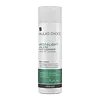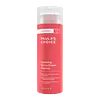What's inside
What's inside
 Key Ingredients
Key Ingredients

 Benefits
Benefits

 Concerns
Concerns

 Ingredients Side-by-side
Ingredients Side-by-side

Water
Skin ConditioningGlycerin
HumectantSodium Laureth Sulfate
CleansingSodium PCA
HumectantSodium Lactate
BufferingGlycine
BufferingFructose
HumectantUrea
BufferingNiacinamide
SmoothingInositol
HumectantLactic Acid
BufferingAllantoin
Skin ConditioningSodium Hyaluronate
HumectantPEG-7 Glyceryl Cocoate
EmulsifyingSodium Methyl Cocoyl Taurate
CleansingXanthan Gum
EmulsifyingTriethanolamine
BufferingCarbomer
Emulsion StabilisingBenzophenone-3
UV AbsorberSodium Hydroxymethylglycinate
PreservativePropylparaben
PreservativeMethylparaben
PreservativeSodium Benzoate
MaskingWater, Glycerin, Sodium Laureth Sulfate, Sodium PCA, Sodium Lactate, Glycine, Fructose, Urea, Niacinamide, Inositol, Lactic Acid, Allantoin, Sodium Hyaluronate, PEG-7 Glyceryl Cocoate, Sodium Methyl Cocoyl Taurate, Xanthan Gum, Triethanolamine, Carbomer, Benzophenone-3, Sodium Hydroxymethylglycinate, Propylparaben, Methylparaben, Sodium Benzoate
Water
Skin ConditioningSodium Cocoyl Glycinate
CleansingCocamidopropyl Hydroxysultaine
CleansingSodium Lauroamphoacetate
CleansingCocamidopropyl Betaine
CleansingGlycerin
HumectantSorbeth-230 Tetraoleate
EmulsifyingDecyl Glucoside
CleansingPentylene Glycol
Skin ConditioningSodium Chloride
MaskingDisodium Cocoyl Glutamate
CleansingLauric Acid
CleansingLactic Acid
BufferingSodium Lauroyl Oat Amino Acids
CleansingSorbitan Laurate
EmulsifyingSodium Cocoyl Glutamate
CleansingDisodium EDTA
Aloe Barbadensis Leaf Juice Powder
Skin ConditioningCaprylic/Capric Triglyceride
MaskingCocoyl Proline
Skin ConditioningSodium Citrate
BufferingCamellia Sinensis Leaf Extract
AntimicrobialGlycyrrhiza Glabra Root
Skin ConditioningSodium PCA
HumectantSodium Lactate
BufferingArginine
MaskingGlycine Soja Sterols
EmollientLinoleic Acid
CleansingPhospholipids
Skin ConditioningAspartic Acid
MaskingPCA
HumectantGlycine
BufferingAlanine
MaskingSerine
MaskingValine
MaskingIsoleucine
Skin ConditioningProline
Skin ConditioningThreonine
Potassium Citrate
BufferingLactoperoxidase
StabilisingHistidine
HumectantPhenylalanine
MaskingGlucose Oxidase
StabilisingCitric Acid
BufferingPhenoxyethanol
PreservativeEthylhexylglycerin
Skin ConditioningPotassium Sorbate
PreservativeSodium Benzoate
MaskingWater, Sodium Cocoyl Glycinate, Cocamidopropyl Hydroxysultaine, Sodium Lauroamphoacetate, Cocamidopropyl Betaine, Glycerin, Sorbeth-230 Tetraoleate, Decyl Glucoside, Pentylene Glycol, Sodium Chloride, Disodium Cocoyl Glutamate, Lauric Acid, Lactic Acid, Sodium Lauroyl Oat Amino Acids, Sorbitan Laurate, Sodium Cocoyl Glutamate, Disodium EDTA, Aloe Barbadensis Leaf Juice Powder, Caprylic/Capric Triglyceride, Cocoyl Proline, Sodium Citrate, Camellia Sinensis Leaf Extract, Glycyrrhiza Glabra Root, Sodium PCA, Sodium Lactate, Arginine, Glycine Soja Sterols, Linoleic Acid, Phospholipids, Aspartic Acid, PCA, Glycine, Alanine, Serine, Valine, Isoleucine, Proline, Threonine, Potassium Citrate, Lactoperoxidase, Histidine, Phenylalanine, Glucose Oxidase, Citric Acid, Phenoxyethanol, Ethylhexylglycerin, Potassium Sorbate, Sodium Benzoate
 Reviews
Reviews

Ingredients Explained
These ingredients are found in both products.
Ingredients higher up in an ingredient list are typically present in a larger amount.
Glycerin is already naturally found in your skin. It helps moisturize and protect your skin.
A study from 2016 found glycerin to be more effective as a humectant than AHAs and hyaluronic acid.
As a humectant, it helps the skin stay hydrated by pulling moisture to your skin. The low molecular weight of glycerin allows it to pull moisture into the deeper layers of your skin.
Hydrated skin improves your skin barrier; Your skin barrier helps protect against irritants and bacteria.
Glycerin has also been found to have antimicrobial and antiviral properties. Due to these properties, glycerin is often used in wound and burn treatments.
In cosmetics, glycerin is usually derived from plants such as soybean or palm. However, it can also be sourced from animals, such as tallow or animal fat.
This ingredient is organic, colorless, odorless, and non-toxic.
Glycerin is the name for this ingredient in American English. British English uses Glycerol/Glycerine.
Learn more about GlycerinThis ingredient is an amino acid that helps build proteins and moisturizes skin. It is already present in our skin as our bodies produce them naturally.
Glycine already plays a role in helping keep our skin moisturized as amino acids transport moisture throughout our skin.
As collagen is made up of glycine and other amino acids, it is believed glycine may help our skin produce more collagen.
Learn more about GlycineLactic Acid is another well-loved alpha hydroxy acid (AHA). It is gentler than glycolic acid but still highly effective.
Its main role is to exfoliate the surface of the skin by loosening the “glue” that holds dead skin cells together. Shedding those old cells leads to smoother, softer, and more even-toned skin.
Because lactic acid molecules are larger than glycolic acid, they don’t penetrate as deeply. This means they’re less likely to sting or irritate, making it a great choice for beginners or those with sensitive skin.
Like glycolic acid, it can:
Lactic acid also acts as a humectant (like hyaluronic acid). It can draw water into the skin to improve hydration and also plays a role in the skin's natural moisturizing factor (NMF) in the form of sodium lactate.
Studies show it can boost ceramide production to strengthen the skin barrier and even help balance the skin’s microbiome.
To get results, choose products with a pH between 3-4.
Lower strengths (5-12%) focus on surface exfoliation; higher strengths (12% and up) can reach deeper in the dermis (deeper, supportive layer) to improve skin texture and firmness over time.
Though it was originally derived from milk, most modern lactic acid used in skincare is vegan. It is made through non-dairy fermentation to create a bio-identical and stable form suitable for all formulations.
When lactic acid shows up near the end of an ingredient list, it usually means the brand added just a tiny amount to adjust the product’s pH.
Legend has it that Cleopatra used to bathe in sour milk to help reduce wrinkles.
Lactic acid is truly a gentle multitasker: it exfoliates, hydrates, strengthens, and brightens. It's a great ingredient for giving your skin a smooth, glowing, and healthy look without the harshness of stronger acids.
Read more about some other popular AHA's here:
Learn more about Lactic AcidSodium Benzoate is a preservative. It's used in both cosmetic and food products to inhibit the growth of mold and bacteria. It is typically produced synthetically.
Both the US FDA and EU Health Committee have approved the use of sodium benzoate. In the US, levels of 0.1% (of the total product) are allowed.
Sodium benzoate works as a preservative by inhibiting the growth of bacteria inside of cells. It prevents the cell from fermenting a type of sugar using an enzyme called phosphofructokinase.
It is the salt of benzoic acid. Foods containing sodium benzoate include soda, salad dressings, condiments, fruit juices, wines, and snack foods.
Studies for using ascorbic acid and sodium benzoate in cosmetics are lacking, especially in skincare routines with multiple steps.
We always recommend speaking with a professional, such as a dermatologist, if you have any concerns.
Learn more about Sodium BenzoateSodium Lactate is the sodium salt of lactic acid, an AHA. It is a humectant and sometimes used to adjust the pH of a product.
This ingredient is part of our skin's NMF, or natural moisturizing factor. Our NMF is essential for the hydration of our top skin layers and plasticity of skin. NMF also influences our skin's natural acid mantle and pH, which protects our skin from harmful bacteria.
High percentages of Sodium Lactate can have an exfoliating effect.
Fun fact: Sodium Lactate is produced from fermented sugar.
Learn more about Sodium LactateSodium PCA is the sodium salt of pyroglutamic acid. It is naturally occurring in our skin's natural moisturizing factors where it works to maintain hydration.
The PCA stands for pyrrolidone carboxylic acid, a natural amino acid derivative.
This ingredient has skin conditioning, anti-inflammatory, and humectant properties. Humectants help hydrate your skin by drawing moisture from the air. This helps keep your skin moisturized.
Learn more about Sodium PCAWater. It's the most common cosmetic ingredient of all. You'll usually see it at the top of ingredient lists, meaning that it makes up the largest part of the product.
So why is it so popular? Water most often acts as a solvent - this means that it helps dissolve other ingredients into the formulation.
You'll also recognize water as that liquid we all need to stay alive. If you see this, drink a glass of water. Stay hydrated!
Learn more about Water